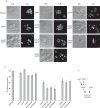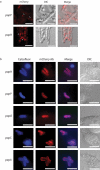A unique aspartyl protease gene expansion in Talaromyces marneffei plays a role in growth inside host phagocytes
- PMID: 30880596
- PMCID: PMC6527018
- DOI: 10.1080/21505594.2019.1593776
A unique aspartyl protease gene expansion in Talaromyces marneffei plays a role in growth inside host phagocytes
Abstract
Aspartyl proteases are a widely represented class of proteolytic enzymes found in eukaryotes and retroviruses. They have been associated with pathogenicity in a range of disease-causing microorganisms. The dimorphic human-pathogenic fungus Talaromyces marneffei has a large expansion of these proteases identified through genomic analyses. Here we characterize the expansion of these genes (pop - paralogue of pep) and their role in T. marneffei using computational and molecular approaches. Many of the genes in this monophyletic family show copy number variation and positive selection despite the preservation of functional regions and possible redundancy. We show that the expression profile of these genes differs and some are expressed during intracellular growth in the host. Several of these proteins have distinctive localization as well as both additive and epistatic effects on the formation of yeast cells during macrophage infections. The data suggest that this is a recently evolved aspartyl protease gene family which affects intracellular growth and contributes to the pathogenicity of T. marneffei.
Keywords: aspartyl protease; evolution; pathogenic fungi.
Figures







Similar articles
-
Extensive Metabolic Remodeling Differentiates Non-pathogenic and Pathogenic Growth Forms of the Dimorphic Pathogen Talaromyces marneffei.Front Cell Infect Microbiol. 2017 Aug 17;7:368. doi: 10.3389/fcimb.2017.00368. eCollection 2017. Front Cell Infect Microbiol. 2017. PMID: 28861398 Free PMC article.
-
Novel Partitivirus Enhances Virulence of and Causes Aberrant Gene Expression in Talaromyces marneffei.mBio. 2018 Jun 12;9(3):e00947-18. doi: 10.1128/mBio.00947-18. mBio. 2018. PMID: 29895639 Free PMC article.
-
The yapA Encodes bZIP Transcription Factor Involved in Stress Tolerance in Pathogenic Fungus Talaromyces marneffei.PLoS One. 2016 Oct 5;11(10):e0163778. doi: 10.1371/journal.pone.0163778. eCollection 2016. PLoS One. 2016. PMID: 27706212 Free PMC article.
-
Organism-wide studies into pathogenicity and morphogenesis in Talaromyces marneffei.Future Microbiol. 2016;11(4):511-26. doi: 10.2217/fmb.16.9. Epub 2016 Apr 13. Future Microbiol. 2016. PMID: 27073980 Review.
-
Adaptation to macrophage killing by Talaromyces marneffei.Future Sci OA. 2017 Jun 30;3(3):FSO215. doi: 10.4155/fsoa-2017-0032. eCollection 2017 Aug. Future Sci OA. 2017. PMID: 28884011 Free PMC article. Review.
Cited by
-
Extracellular vesicles derived from Talaromyces marneffei contain immunogenic compounds and modulate THP-1 macrophage responses.Front Immunol. 2023 Jun 29;14:1192326. doi: 10.3389/fimmu.2023.1192326. eCollection 2023. Front Immunol. 2023. PMID: 37457708 Free PMC article.
-
Bioinformatic analysis of the pathogenic mechanism of talaromyces marneffei infection.Medicine (Baltimore). 2020 Nov 25;99(48):e23409. doi: 10.1097/MD.0000000000023409. Medicine (Baltimore). 2020. PMID: 33235120 Free PMC article.
-
An Overview of Diagnostic and Management Strategies for Talaromycosis, an Underrated Disease.J Fungi (Basel). 2023 Jun 6;9(6):647. doi: 10.3390/jof9060647. J Fungi (Basel). 2023. PMID: 37367583 Free PMC article. Review.
-
Unraveling the dynamic transcriptomic changes during the dimorphic transition of Talaromyces marneffei through time-course analysis.Front Microbiol. 2024 Apr 24;15:1369349. doi: 10.3389/fmicb.2024.1369349. eCollection 2024. Front Microbiol. 2024. PMID: 38721600 Free PMC article.
-
The Effect of Talaromyces marneffei Infection on CD86 Expression in THP-1 Cells.Infect Drug Resist. 2021 Feb 19;14:651-660. doi: 10.2147/IDR.S297160. eCollection 2021. Infect Drug Resist. 2021. PMID: 33642869 Free PMC article.
References
Publication types
MeSH terms
Substances
LinkOut - more resources
Full Text Sources
Other Literature Sources
Miscellaneous
